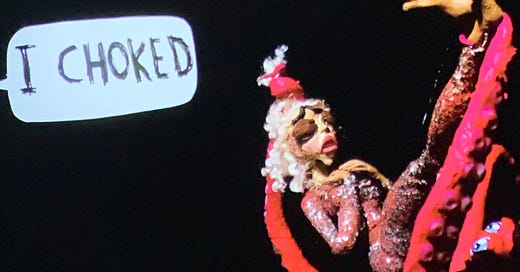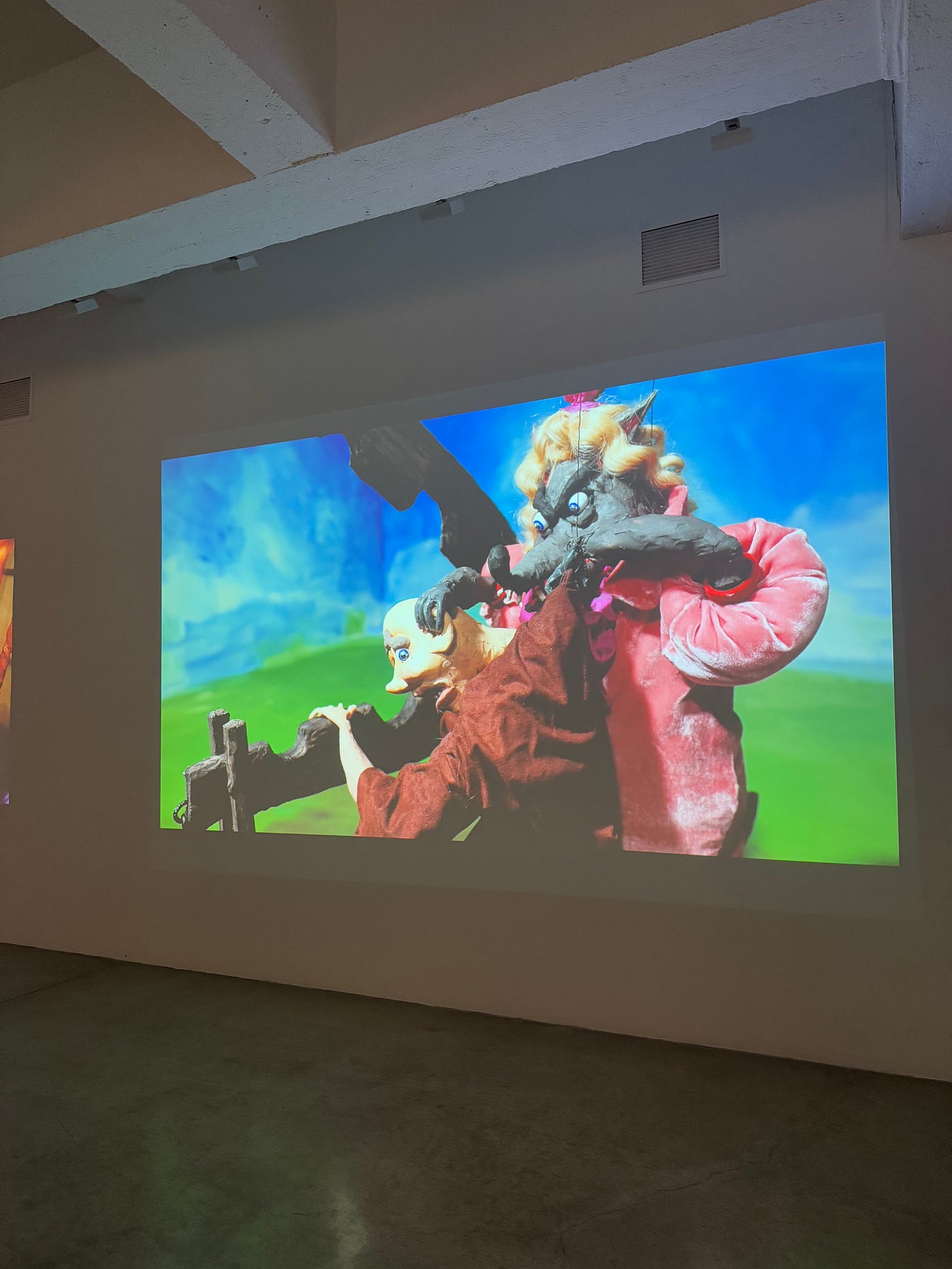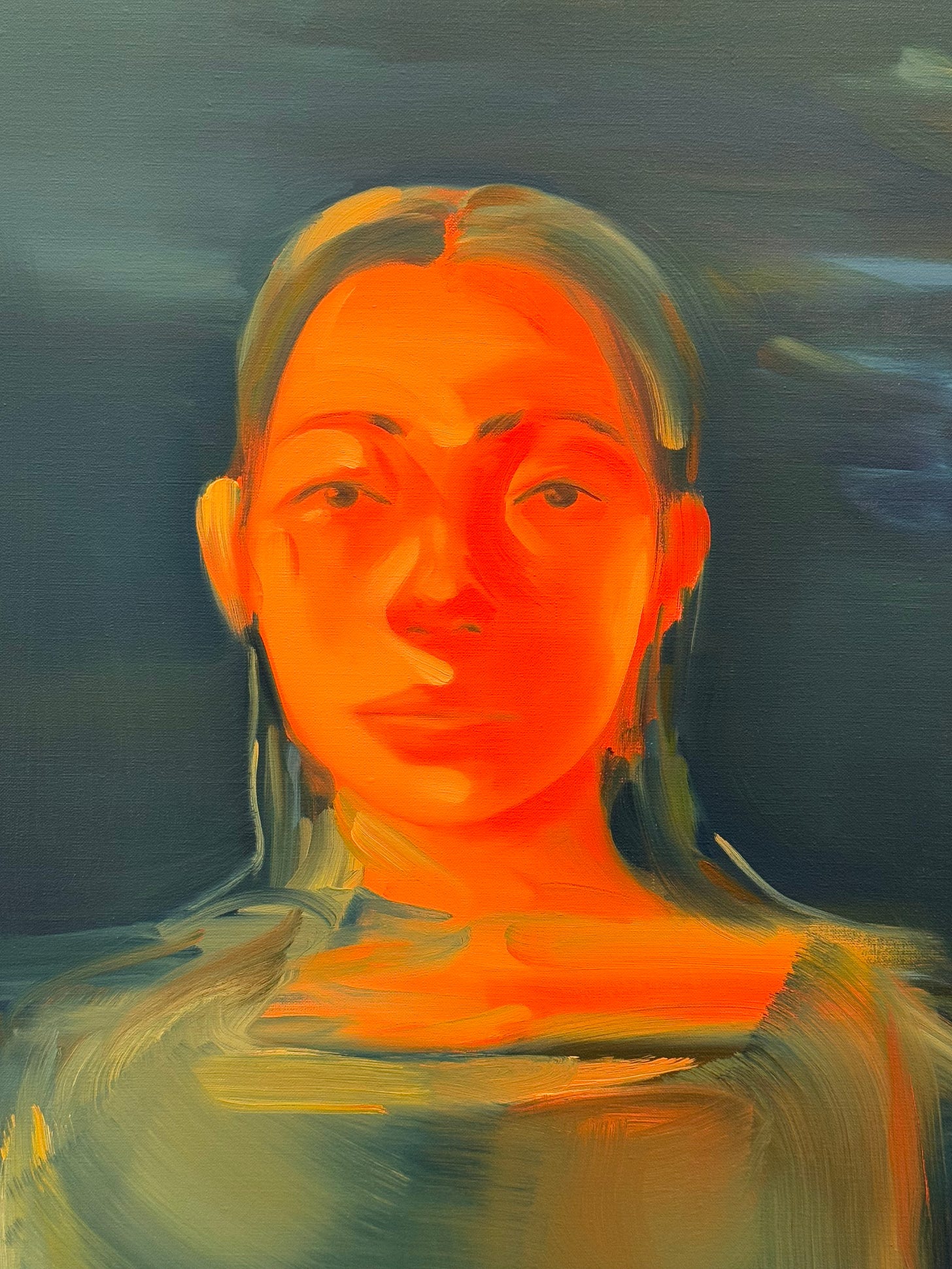There are certain art experiences that have lodged themselves in my memory, usually because they mark a change in my understanding of my own tastes. There will have been something challenging, unexpected, dark or perverse in a way that makes me want to press forward, stay a while.
One such experience was my first brush with the work of Nathalie Djurberg and Hans Berg almost exactly six years ago, December 2019. It was freezing cold, I was wearing a skirt with a high slit and no tights underneath, and the winds off the Hudson River were relentless, as they almost always are in that corridor of the city.
I slipped into Tanya Bonakdar on a whim, to escape the cold. It’s not a gallery I frequent, but I stumbled upon a Djurberg and Berg show and haven’t stopped thinking about it since.
I love the Art21 series in general, and this one^ is a good primer on how the work is made. Djurberg does the messy, tedious job of building figurines and sets for stop-motion video shorts, and her creative partner, Berg, is a composer who sets it all to original music.
The fruits of their labor are video pieces featuring animals, houses, planets, and humans as characters that exhibit unhindered greed, childlike stubbornness, and sadistic sexual tendencies. They are bawdy and funny and disturbing, a perfect example of how art allows us to act out our worst impulses in a place where they can help rather than harm others. They are delightfully weird, something for the freaks among us. They are also parables that don’t preach, entertaining stories of sin and our base nature that neither trivialize nor proselytize.
On a technical level, the music is beautiful and demonstrates the sweeping range of Berg’s composing ability. The animation is stunning—Djurberg’s chosen medium is extremely laborious and time-intensive, a commitment to telling each story that demands respect and attention from viewers.
I highly recommend checking out their new work at Tanya Bonakdar (through February 20), and have some other stellar recommendations to catch while you’re in the neighborhood. Bundle up, it’s cold as hell over there!
Nathalie Djurberg and Hans Berg, “Only for the Wicked” at Tanya Bonakdar (521 W 21st Street) - If you aren’t convinced already, I have nothing more to say to you!
Giorgio Morandi at David Zwirner (537 W 20th Street) - I enjoy that Zwirner at least annually has some big retrospective of a canonical artist (another blockbuster was the Diane Arbus exhibition in 2022) that feels more like a curated museum experience than a typical gallery visit. “Giorgio Morandi: Masterpieces from the Magnani-Rocca Foundation” is one such retrospective, and I left with a newfound appreciation for Morandi’s wobbly brushstrokes, subdued but assured color palette, and the simplicity of his forms. You can really see how we got from classical still life painting to Morandi to Guston.
Camille Henrot at Hauser and Wirth (542 W 22nd Street) - This show features a “flooring intervention” (A.K.A. flooring) by the in-demand geniuses at Charlap Hyman & Herrero, which is very cool and design-y of them and does lend a lot of context to the work, so I applaud them for the commitment. I prefer the sculptures to the paintings, which are a little too “digital” looking for my taste. The sculptures are very special, playful, and evocative. Like the best art, they make you feel a strange twinge of recognition, a deja vu feeling or recalling something so faintly it could be imagined, dreamt, or an unplaceable memory.
Simphiwe Mbunyuza at David Kordansky (520 W 20th Street) - The tallest of Mbunyuza’s ceramic vessels stands at five feet and wider than a hug could encompass, impressive to behold. But even the smallest one bears intricate carvings and beautiful, saturated glazing, emblazoned with cows and houses, lined with neat crosshatching and spiked with horn shapes.
HONORABLE MENTIONS
Na Kim at Nicola Vassell (138 10th Avenue) - I enjoy Kim’s work and was happy to see she was showing with Vassell, a new-ish gallery with a good eye.
THE (grand) GESTURE at the newly renamed Sikkema Malloy Jenkins (530 W 22nd Street) - Particularly the Arturo Herrera pieces, which tidily cinched together the themes of movement across the artists included.
Honestly not sure where or when I first heard of Douglas Coupland but I purchased and promptly read “Shopping In Jail: Ideas, Essays, and Stories for the Increasingly Real Twenty-First Century” and never looked back.
There is an essay inside titled “All Governments Seem to Be Winging it Except for China.” Like, what’s not to love? If you’re interested in the human condition TODAY when, as the forward argues, data supersedes DNA in importance, this is a must-read.
Coupland talks a lot about the internet. I recently listened to this conversation between Ben Davis and D*an K*ssick (JK) of recent “The Painted Protest” fame. I found the podcast episode more helpful and interesting than the controversial essay that inspired it. Kissick argues that the cultural creative output of our time period is more meme than art, and we will be remembered in history for production of short-form internet content rather than fine art. He considers much of the art being made today as regressive, safe, and uninteresting, with our collective attention and energy focused on the bottomless appetite of internet audiences.
It made me think: it’s really hard to understand and synthesize a moment as you’re in it. Sometimes, trying to do so makes you look like an asshole.
But Coupland does it better with humor, curiosity, and apparent interest. He says many of the same things as Kissick, but over a decade earlier and with the emphasis on craft that Kissick complains is absent from the critiques of his piece.
“One point that does seem to be a little bit undeniable now is that contemporary art seems to be sputtering a bit—much of it is starting to look old-fashioned which is, in its own way, exciting because it means modern art is shortly due for a reimagining, which is why it exists, so hurray for sputtering.”
If you keep reading, you’ll see that Coupland is able to imagine and offer a vision of what the future might look like rather than a displeased screed against the present:
“In an ever-flattening world of downloaded nonphysical experiences, the crafted object is in the ascendant, and ultimately might prove to be the trunk of the tree that gives rise to the next dominant wave of modern art.”
I hope you get out to see some art this week! Tell me what else is good. :) xx













